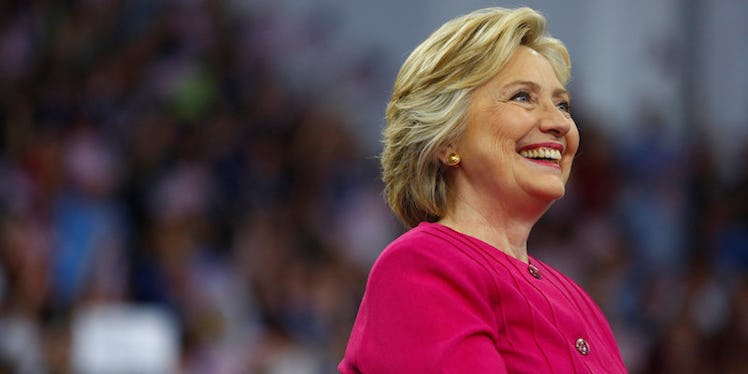
What Hillary Clinton Wore Last Night Doesn't Matter, So Stop Talking About It
Listen up, people. We have an issue. An issue few are talking about. One that transcends party lines and policy proposals. No matter how conservative or liberal you are, no matter what you think of Donald Trump or Hillary Clinton, no matter how you feel about abortion or gay marriage, this is an issue that applies to all of you.
None of us, absolutely no one, should be talking about Hillary Clinton's clothing.
As we officially enter the last stretch of this presidential election, it has become painfully evident that women's wardrobe choices have been playing too big a role in both media coverage and our own perception of candidates.
Hillary recently came under fire for wearing a $12,495 Armani jacket during a speech about inequality, according to CNBC. People claimed that she was exhibiting serious hypocrisy by claiming to understand and want to end the economic inequality of this nation, all the meanwhile wearing a jacket that cost more than most people make in a month.
Firstly, the report was mostly false. But let's take a step back here and consider what might have led to Clinton's decision to wear such an expensive outfit, one that was clearly purposefully chosen.
Women in politics have been scrutinized for their wardrobe choices for far, far too long, and such scrutiny has made the headlines (and not just in fashion magazines) more than once in our recent election cycles. An article on TIME Magazine highlights the fashion looks of Sarah Palin, McCain's vice-presidential nominee in 2008. This is literally just a slideshow of pictures of Mrs. Palin in different outfits.
Elizabeth Warren, having risen to increased popularity in the past few months due to her support for Clinton, has been subjected to careful examination of her fashion choices. The Denver Post published a piece about how Warren "sends a defining messages with her clothing choices.” What follows is a detailed description of how she utilizes her accessories and outfits to send a message:
Warren favors trim jackets in … TV-friendly colors … [she] likes bracelet sleeves, … but she typically does not wear a bracelet or even a watch.
Obviously, the details of Warren's cutest blazers entrance readers — why would they not?
Most recently, on the last day of the 2016 DNC, ATTN: found that the most-searched question about Hillary Clinton was what she would be wearing for her speech. That's right — not what policy she might be bringing up, or if she would acknowledge the ongoing protests. No. What she would be wearing was more important than any of that.
This brings me to point out a clear discrepancy that is gender-based: male politicians' suits and ties rarely make media coverage. Even if they do, the subject is approached with a noticeably different tone and attitude.
In an article by the Washington Post published in October 2015, “Why does Bernie Sanders dress like that? Because he can,”
In October 2015, the Washington Post published an article titled "Why does Bernie Sanders dress like that? Because he can." Sanders' specific clothing choices were not discussed, but rather, the fact that he sometimes would forego the typical suit or button up the top of his shirt was lauded, for it communicated an authenticity other candidates simply didn't have.
Even though this piece freely acknowledged that Sanders does not always look put-together, it suggested that it doesn't matter because his style communicates a message about his campaign. That's what's important: his message, not his clothing.
Given all this, it can be no surprise that Clinton wore an expensive Armani jacket on the campaign trail. According to the New York Post, Clinton's 2016 campaign staff have made a visible effort to use her fashion and style to make her more relatable and likable. When her every fashion choice is under the keen eyes of the media, how can she afford to skimp on her clothing? In 2008 when she “regularly recycled outfits,” people weren't happy. Now, in 2016, she's spent thousands trying to recreate her fashion image, and people still aren't happy.
As we enter the last stage of our presidential election, I urge everyone to be a bit more wary of the scrutiny we place female politicians under for their wardrobe choices. Media coverage like this undermines female politicians' policy proposals, intelligence and overall capabilities. Regardless of your political stance and beliefs, it is inherently sexist for the media to propagate such a gender-based double standard for expectations of fashion sense, and what Hillary Clinton wears is far from the most important issue of this election. Let's start paying attention to what matters, and leave the conversation about fashion behind already.
Citations: CNBC, TIME, Snopes, Denver Post, ATTN:, Washington Post